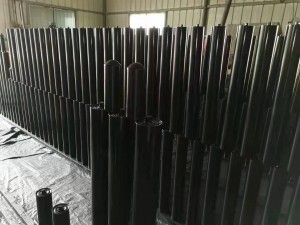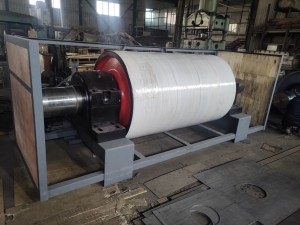
Belt conveyor is widely used in mining, metallurgy, coal, transportation, hydropower, chemical industry and other departments due to its advantages of large conveying capacity, simple structure, convenient maintenance, low cost, and strong universality. Problems of belt conveyor will directly affect production. This article shares common problems and possible causes in the operation of belt conveyor.
1. The conveyor belt deviates at the tail roller
Possible causes: a. Idler is stuck; b. Accumulation of material scraps; c. Insufficient counterweight; d. Improper loading and material spraying; e. Idlers, rollers and conveyors are not on the center line.
2. The conveyor belt deviates at any point
Possible causes: a. Partial load; b. Accumulation of material scraps; c. The idler is not properly aligned; d One side of the conveyor belt is subject to transition tension; e. Improper loading and material spraying; f. Idlers, rollers and conveyors are not on the center line.
3. Part of the conveyor belt deviates at any point
Possible causes: a. Poor performance of conveyor belt vulcanization joint and improper selection of mechanical buckle; b. Edge wear; c. The conveyor belt is curved.
4. The conveyor belt deviates at the head roller
Possible causes: a. Idlers, rollers and conveyors are not on the center line; b. Accumulation of material scraps; c. The rubber surface of the drum is worn; d. The idler is improperly installed.
5. The conveyor belt deviates to one side in a whole section on several specific idlers
Possible causes: a. Idlers, rollers and conveyors are not on the center line; b. The idler is improperly installed; c. Accumulation of material scraps.
6. Belt slipping
Possible causes: a. Idler is stuck; b. Accumulation of material scraps; c. The rubber surface of the roller is worn; d. Insufficient counterweight; e. Insufficient friction between conveyor belt and roller.
7. The conveyor belt slips during startup
Possible causes: a. Insufficient friction between conveyor belt and roller; b. Insufficient counterweight; c. The rubber surface of the drum is worn; d. The conveyor belt is not strong enough.
8. Excessive belt elongation
Possible causes: a. Excessive tension; b. The conveyor belt is not strong enough; c. Accumulation of material scraps; d. The counterweight is too large; e. Non synchronous operation of double drive roller; f. Damage caused by chemical substances, acid, heat and surface roughness.
9. The conveyor belt is broken or loosened at or near the buckle
Possible causes: a. The strength of the conveyor belt is not enough; b. The roller diameter is too small; c. Excessive tension; d. The rubber surface of the drum is worn; e. The counterweight is too large; f. There are foreign matters between the conveyor belt and the roller; g. Non synchronous operation of double drive drum; h. The vulcanization joint of the conveyor belt has poor performance, and the mechanical buckle is improperly selected.
10. Fracture of vulcanized joint
Possible causes: a. The conveyor belt is not strong enough; b. The roller diameter is too small; c. Excessive tension; d. There are foreign matters between the conveyor belt and the roller; e. Non synchronous operation of double drive roller; f. The vulcanization joint of the conveyor belt has poor performance, and the mechanical buckle is improperly selected.
11. The upper covering rubber is severely worn, including tearing, gouging, breaking and puncturing
Possible causes: a. Accumulation of material scraps; b. Improper loading and material spraying; c. The relative loading speed is too high or too low; d. Excessive impact of load on buckle; e. Damage caused by chemical substances, acid, heat and surface roughness.
12. The lower covering rubber is severely worn
Possible causes: a. Idler is stuck; b. Accumulation of material scraps; c. The rubber surface of the drum is worn; d. There are foreign matters between the conveyor belt and the roller; e. Insufficient friction between conveyor belt and roller; f. Damage caused by chemical substances, acid, heat and surface roughness.
13. The edge of conveyor belt is severely worn
Possible causes: a. Partial load; b. One side of the conveyor belt is subject to excessive tension; c. Improper loading and material spraying; d. Damage caused by chemical substances, acids, heat and rough surface materials; e. The conveyor belt is arc-shaped; f. Accumulation of material scraps; g. The vulcanization joint of the conveyor belt has poor performance, and the mechanical buckle is improperly selected.
14. Punctate and striped bubbles exist in the covering layer
Possible causes: damage caused by chemical substances, acids, heat and rough surface materials.
15. Hardening and cracking of conveyor belt
Possible causes: a. Damage caused by chemical substances, acids, heat and rough surface materials; b. The roller diameter is small; c. The rubber surface of the roller is worn.
16. Embrittlement and cracking of covering layer
Possible causes: damage caused by chemical substances, acids, heat and rough surface materials.
17. There are longitudinal grooves on the upper cover
Possible causes: a. Improper installation of side baffle; b. Idler is stuck; c. Accumulation of material scraps; d. The load has too much impact on the buckle.
18. The lower covering adhesive has longitudinal grooves
Possible causes: a. Idler is stuck; b. Accumulation of material scraps; c. The rubber surface of the roller is worn.
19. The groove of idler is damaged
Possible causes: a. Excessive idler clearance; b. The gradient of grade change point is too large.
Web: https://www.sinocoalition.com/
Email: sale@sinocoalition.com
Phone: +86 15640380985
Post time: Sep-22-2022







